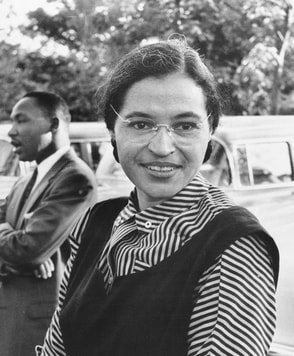|
Many people know Rosa Parks as the black girl who refused to give up her seat to a white person on a bus. Even Doctor Who portrayed the story in a recent episode, but how many people know Rosa’s background? How many people know more about her than the bus incident? She is a recognisable name in the Civil Rights Movement, but is that all - just a name?
Born Rosa Louise McCauley on 4th February 1913, Rosa grew up in Tuskegee, Alabama, until her parents, Leona and James, separated. Rosa moved to Montgomery with her mother and younger brother Sylvester, where she lived on her grandparents' farm and attended the African Methodist Episcopal Church. Rosa’s mother taught her how to sew, and by the age of ten, Rosa completed her first quilt. She continued to sew while studying academic courses at the Montgomery Industrial School for Girls, making herself dresses to wear. Although Rosa enrolled at a high school set up by the Alabama State Teachers College for Negroes, she dropped out when her grandmother became unwell. In 1932, Rosa married the barber Raymond Parks, who belonged to the National Association for the Advancement of Colored People (NAACP). Rosa took on jobs as a domestic worker, but her husband encouraged her to complete her high school education, which she achieved in 1933. A decade later, Rosa joined the NAACP, becoming its first female secretary. For some time, she was also the only female member. As part of her role, Rosa investigated false rape claims against black men and the gang-rape of Recy Taylor (1919-2017), a black woman from Abbeville, Alabama. The Chicago Defender called the resulting campaign concerning the latter "the strongest campaign for equal justice to be seen in a decade." Rosa experienced “integrated life” while briefly working for the Maxwell Air Force Base, which did not condone racial segregation. This made her realise the extent of the differences between the lives of blacks and whites. Rosa also worked as a domestic and seamstress for Clifford (1899-1975) and Virginia Durr (1903-99), a white couple who encouraged and sponsored her attendance at the Highlander Folk School to learn more about civil rights in 1955. To travel to and from work and school, Rosa used public buses, which since 1900 had specific seating areas for blacks and whites. The front four rows were for whites only, and blacks were encouraged to sit at the far end of the bus. Over 75% of passengers were black, which made the rear of the bus very crowded. Blacks also had to use the back door of the bus, but on one occasion it was too crowded for Rosa, so she used the front entrance instead. After paying, the driver insisted she leave the bus and enter through the back door. As soon as Rosa had stepped out of the bus, the driver sped away. Rosa avoided that bus driver until 1955 after a long day at work. She did everything right: she entered the bus through the back door and sat in the first row of seats designated for black people. During the journey, crowds of people entered the bus, meaning many people had to stand, including white people. Seeing this, the driver asked those in the first row of black seats to stand up so the whites could sit. Whilst three blacks got up and moved, Rosa remained seated. The driver demanded her to move, and when she did not, he called the police. The police arrested Rosa and charged her with a violation of Chapter 6, Section 11 segregation law of the Montgomery City code. The NAACP bailed her out of prison that evening. “People always say that I didn't give up my seat because I was tired, but that isn't true. I was not tired physically, or no more tired than I usually was at the end of a working day. I was not old, although some people have an image of me as being old then. I was forty-two. No, the only tired I was, was tired of giving in.” - Rosa Parks, Rosa Parks: My Story, 1992 Rosa Parks was not the first person to refuse to give up her seat, but her actions inspired the NAACP to organise a bus boycott. On 5th December 1955, the day of Rosa’s trial, campaigners distributed 35,000 leaflets saying: “We are ... asking every Negro to stay off the buses Monday in protest of the arrest and trial ... You can afford to stay out of school for one day. If you work, take a cab, or walk. But please, children and grown-ups, don't ride the bus at all on Monday. Please stay off the buses Monday.” That day, over 40,000 black people walked to work instead of getting the bus. Some had to walk more than 20 miles through the driving rain. As Rosa’s trial continued, so did the bus boycott. For 381 days, black people in Montgomery avoided using the bus. Since they made up at least 75% of commuters, the bus companies suffered from a loss of bus fares, forcing the city to repeal its law about segregation on public transport. Rosa did not wish to take credit for this success, and Martin Luther King Jr agreed that Rosa was not the cause of the boycott but the catalyst: "The cause lay deep in the record of similar injustices." Although Rosa became an icon of the Civil Rights Movement, she suffered as a result. She received many death threats, disagreed with King’s approaches, and both she and her husband lost their jobs, prompting them to move to Hampton in Virginia in search of work. Rosa found a position as a hostess but soon moved to live with her brother in Detroit, Michigan. Her brother believed the discrimination against blacks to be less severe in the northern states, but Rosa failed to see any improvements. When African American John Conyers (1929-2019) stood for Congress, Rosa gave him her full support and convinced King to do the same. After Conyers' election, he hired Rosa as his secretary and receptionist, a position she kept until she retired in 1988. She visited schools, hospitals and facilities with and on Conyers’ behalf, plus attended Civil Rights marches across the country. During this time she became an ally of Malcolm X. She later took part in the black power movement. Rosa continued to support the Civil Rights Movement in various ways, although she never took up a leading position. During the 1970s, she helped to organise the freedom of several prisoners whose actions of self-defence had landed them in police custody. Unfortunately, Rosa could not contribute much later that decade due to the poor health of her family, although she donated what little money she could to the cause. In 1977, both her husband and brother passed away from cancer. Following these losses, she broke two bones after slipping on an icy pavement, prompting her to move in with her elderly mother in an apartment for senior citizens. Her mother passed away in 1979 aged 92. With renewed vigour, Rosa returned to the Civil Rights scene, co-founding the Rosa L. Parks Scholarship Foundation to provide scholarships for college students. When asked to speak at various organisations, Rosa usually donated her speaking fee to her scholarship foundation. Later, she established the Rosa and Raymond Parks Institute for Self Development, which aimed to "educate and motivate youth and adults, particularly African American persons, for self and community betterment.” In her later years, Rosa faced several challenges. At 81, a man broke into her house and demanded money. When she refused, he attacked her, landing her in hospital with facial injuries. Naturally, Rosa suffered severe anxiety after the attack and moved to a secure complex. Whilst she felt safe there, her fragile mind made it difficult for her to manage her finances. In 2002, she received an eviction notice due to lack of rent payment. When members of the public found out, the Hartford Memorial Baptist Church in Detroit raised funds to pay the rent on her behalf, allowing her to remain in her home for the remainder of her life. Rosa Parks passed away at age 92 on 24th October 2005. Before her funeral, a bus, similar to the one on which she refused to stand, drove her casket to the US Capitol in Washington DC where she became the first non-government official to lie in honour in the rotunda. At her memorial service, the United States Secretary of State Condoleezza Rice (b.1954) said she believed that if it had not been for Rosa Parks, she would not be Secretary of State today. At her death, Rosa left an extensive list of legacies, which continues to grow. Long before she passed away, places were named in her honour, such as Rosa Parks Boulevard in Detroit, and she received many medals and awards: Martin Luther King Jr. Award (1980), Presidential Medal of Freedom (1996), Congressional Gold Medal (1999), and several honorary doctorates. Since her death, the Rosa Parks Transit Center has opened in Detroit; Michigan renamed a plaza Rosa Parks Circle; the asteroid 284996 Rosaparks was named in her memory; and the Rosa Parks Railway Station opened in Paris. Americans also remember Rosa Parks with a statue in Montgomery, unveiled in 2019.
0 Comments
Your comment will be posted after it is approved.
Leave a Reply. |
©Copyright
We are happy for you to use any material found here, however, please acknowledge the source: www.gantshillurc.co.uk AuthorRev'd Martin Wheadon Archives
June 2024
Categories
All
|


 RSS Feed
RSS Feed